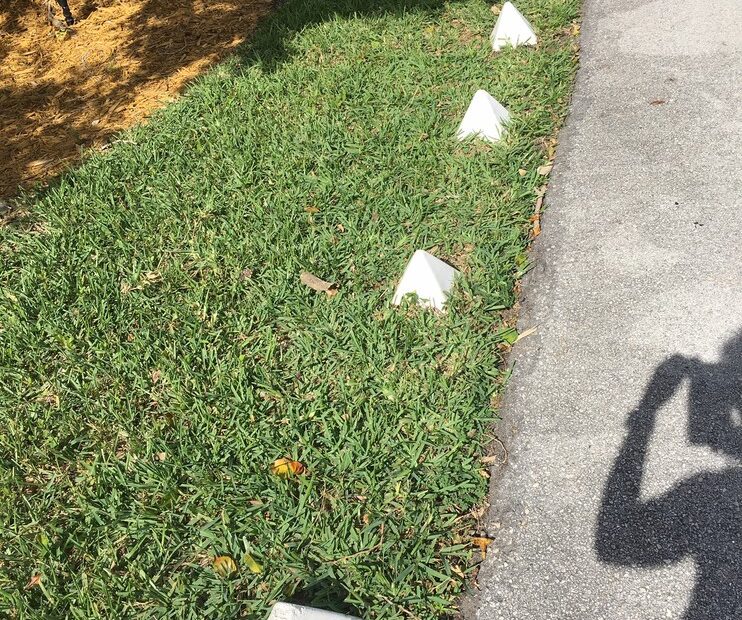Uninvited guests on our perfectly manicured lawns can wreck havoc on our sanity and test our patience to the limit. One peculiar intruder that seems to possess a magnetic attraction to our precious sanctuary is none other than the automobile. Whether it’s an innocent case of a wayward driver mistaking our lawns for a parking lot or a recurring nightmare with repeat offenders, the frustration remains the same. Fear not, for in this article, we shall embark on a creative journey to explore ingenious methods and effective strategies on how to safeguard our sacred turf from these vehicles that have strayed from their rightful path. So brace yourselves, fellow lawn-lovers, as we delve into a world where imagination meets practicality in the quest to banish cars from the tranquility of our cherished green oases.
Understanding the Consequences of Parking on Your Lawn
One common problem faced by many homeowners is cars parking on their lawn. Not only does this detract from the overall appearance of the property, but it can also cause damage to the grass and create drainage issues. is essential for finding effective ways to deter cars from encroaching on your precious green space.
To keep cars from parking on your lawn, consider implementing the following features or tips:
- Install a decorative fence: A beautiful fence can act as a barrier, discouraging drivers from parking on your lawn while adding a touch of elegance to your property.
- Use bollards: Bollards are sturdy posts that can be strategically placed along the edge of your lawn to prevent unauthorized parking. They not only serve as a visual deterrent but also provide physical barriers.
- Plant thick shrubs or hedges: Dense shrubs or hedges positioned around the perimeter of your lawn can act as a natural deterrent, making it difficult for cars to access the area.
| Feature/Tips | Description |
| Clear signage | Ensure that there are clear signs indicating that parking on the lawn is not allowed. This helps raise awareness and reminds drivers of the consequences. |
| Install motion sensor lights | By illuminating your lawn when someone approaches, motion sensor lights can deter individuals from parking there. A well-lit area is less likely to attract unwanted vehicles. |
| Accessible designated parking area | If possible, create a designated parking area near your lawn to divert cars away from it. Providing an alternative spot encourages visitors and residents to park correctly. |

Implementing Passive Deterrents to Discourage Parking on Your Lawn
One of the most irritating problems homeowners face is when cars are constantly parking on their beautifully manicured lawns. Not only does it damage the grass and soil, but it also poses a safety hazard. Fortunately, there are several passive deterrents you can implement to discourage parking on your lawn, ensuring your property remains pristine and free from unwanted vehicles.
Firstly, consider installing decorative fencing or bollards around the perimeter of your lawn. This not only adds an appealing aesthetic to your property but also acts as a physical barrier, clearly indicating that it is not a suitable parking spot. Additionally, you can strategically place large rocks or potted plants along the edge of your lawn, acting as natural obstacles that make it inconvenient for drivers to park their cars there. The presence of visible barriers will deter most individuals from considering your lawn as a potential parking space.
To enhance the effectiveness of these passive deterrents, it’s important to maintain clear and concise communication with those who might be tempted to park on your lawn. Erect bold signage near the entrances to your property stating in clear terms that parking on your lawn is strictly prohibited. To further emphasize this message, you can consider using eye-catching colors or bold font styles. Additionally, it may be helpful to kindly approach neighbors or frequent visitors and politely inform them of your desire to keep cars off your lawn. This open communication will ensure mutual understanding and compliance with your wishes.
| Features | Tips |
|---|---|
| Decorative fencing | – Choose a design that complements your home’s exterior |
| Large rocks or potted plants | – Opt for durable and heavy objects to prevent their removal |
| Bold signage | – Place signs at eye level for maximum visibility |
Remember, while implementing passive deterrents is effective, it’s essential to remain respectful and considerate towards those who may unknowingly or accidentally park on your lawn. By utilizing these methods and maintaining open communication, you can successfully deter cars from parking on your lawn, allowing you to enjoy a lush and unblemished outdoor space.
Utilizing Active Measures to Prevent Cars from Parking on Your Lawn
If you’re tired of cars continuously parking on your beautiful lawn, it’s time to take action. Utilizing active measures can effectively deter vehicles from encroaching on your property. By implementing a few strategies, you can reclaim your lawn and maintain its pristine condition.
Firstly, consider installing physical barriers as a visual deterrent. This can include installing bollards, large rocks, or decorative fencing around the perimeter of your lawn. These obstacles will serve as a clear indication to drivers that parking is not allowed. Additionally, adding prominent signage can further emphasize the message.
| Features/Tips | Benefits |
|---|---|
| Planting flower beds along the boundary | Creating a natural and appealing barrier while discouraging parking. |
| Installing motion sensor lights and security cameras | Deterring potential offenders and providing evidence if needed for legal purposes. |
| Contacting local authorities | Seeking help from local law enforcement or municipal parking enforcement to address the issue. |
Remember, prevention is key! Consistently taking action to prevent cars from parking on your lawn can save you time, effort, and frustration in the long run. Implementing these active measures will not only protect the beauty of your lawn but also send a clear message to individuals that your property is not an acceptable parking spot.

Establishing Positive Communication to Resolve Parking Issues
In order to address the issue of cars parking on your lawn, it is important to establish positive communication with your neighbors and put in place effective strategies to deter unwarranted parking. By maintaining open lines of dialogue and fostering a collaborative approach, you can work towards finding solutions that benefit all parties involved.
One effective strategy is to kindly approach your neighbors and discuss the issue in a non-confrontational manner. Be mindful of their perspective and seek to understand their reasons for parking on your lawn. By remaining calm and open-minded, you can initiate a conversation that revolves around finding practical alternatives. Perhaps suggesting designated parking areas or exploring shared driveway arrangements could be fruitful options.
Another approach is to implement physical deterrents that will discourage vehicles from parking on your lawn. Consider installing large planters, decorative rocks, or low fencing along the perimeter of your property. These physical barriers not only protect the aesthetic appeal of your lawn but also serve as a clear indication that parking is not permitted. Using bold signs or paint to define designated parking areas can also dissuade drivers from mistakenly encroaching on your property. Remember, a positive and respectful approach can go a long way in resolving parking issues and fostering harmonious neighborhood relationships.
| Features/Tips | Description |
|---|---|
| Open communication | Engage in respectful conversations with neighbors to gain insight into their parking habits and discuss potential solutions. |
| Physical deterrents | Implement decorative barriers, planters, rocks, or fencing along the perimeter to make it clear that parking on your lawn is not allowed. |
| Designated parking areas | Suggest or create designated parking spots within your neighborhood to alleviate parking issues and provide clear guidelines for residents. |
Frequently Asked Questions
Q: How do I prevent cars from transforming my lush lawn into a makeshift parking lot?
A: Fear not, for there are creative and effective measures to reclaim your greenery from vehicular invaders!
Q: Can I transform my lawn into an irresistible oasis that cars simply can’t resist avoiding?
A: Absolutely! Create an enchanting curb appeal that entices even the most daunting parking offenders to steer clear of your precious grassy kingdom.
Q: Is there a way to channel my frustration into a DIY solution to deter rogue parkers?
A: Indeed, there is! Unleash your inner handyman/woman and explore simple yet ingenious ways to discourage cars from setting foot on your hallowed turf. As we conclude this whimsical journey through the perplexing world of parking predicaments, we hope you’ve found solace and inspiration to reclaim your lush green paradise from the relentless invasion of unauthorized vehicles. Remember, keeping cars from parking on your lawn requires a combination of creativity, determination, and a dash of neighborly spirit.
As we bid farewell to tire tracks and muddy grooves, let’s recap the ingenious tactics we explored. From creating enchanting flower beds and charming stone pathways to installing subtle deterrents like low fencing or decorative boulders, we uncovered numerous ways to safeguard your lawn while adding an artistic touch to your abode.
However, let’s not forget the importance of empathy and communication. Engaging in neighborly conversations and kindly informing visitors about your lawn’s sacred status can go a long way in preserving peace within your community. After all, it’s through mutual understanding that we find harmony even in the most peculiar situations.
As we step away from the realm of unruly tires and venture back into the realms of everyday life, we encourage you to embrace the challenge head-on, armed with inventive solutions and a creative spirit. Remember, every lawn holds its own story, waiting to be etched by your resourcefulness and visionary flair.
So, dear readers, may your lawns flourish in tranquility and remain car-free havens of green serenity. With these newfound insights, let us embark on a journey where tires remain on roads, boundaries are respected, and lawns are admired from afar.
Until we meet again, happy lawn preservation and may the grass always be greener on your side of the street!
- When to Put Weed and Feed on Lawn in Michigan - October 16, 2023
- When to Fertilize Potatoes Plants - October 16, 2023
- Can You Plant Clover in the Spring - October 16, 2023

